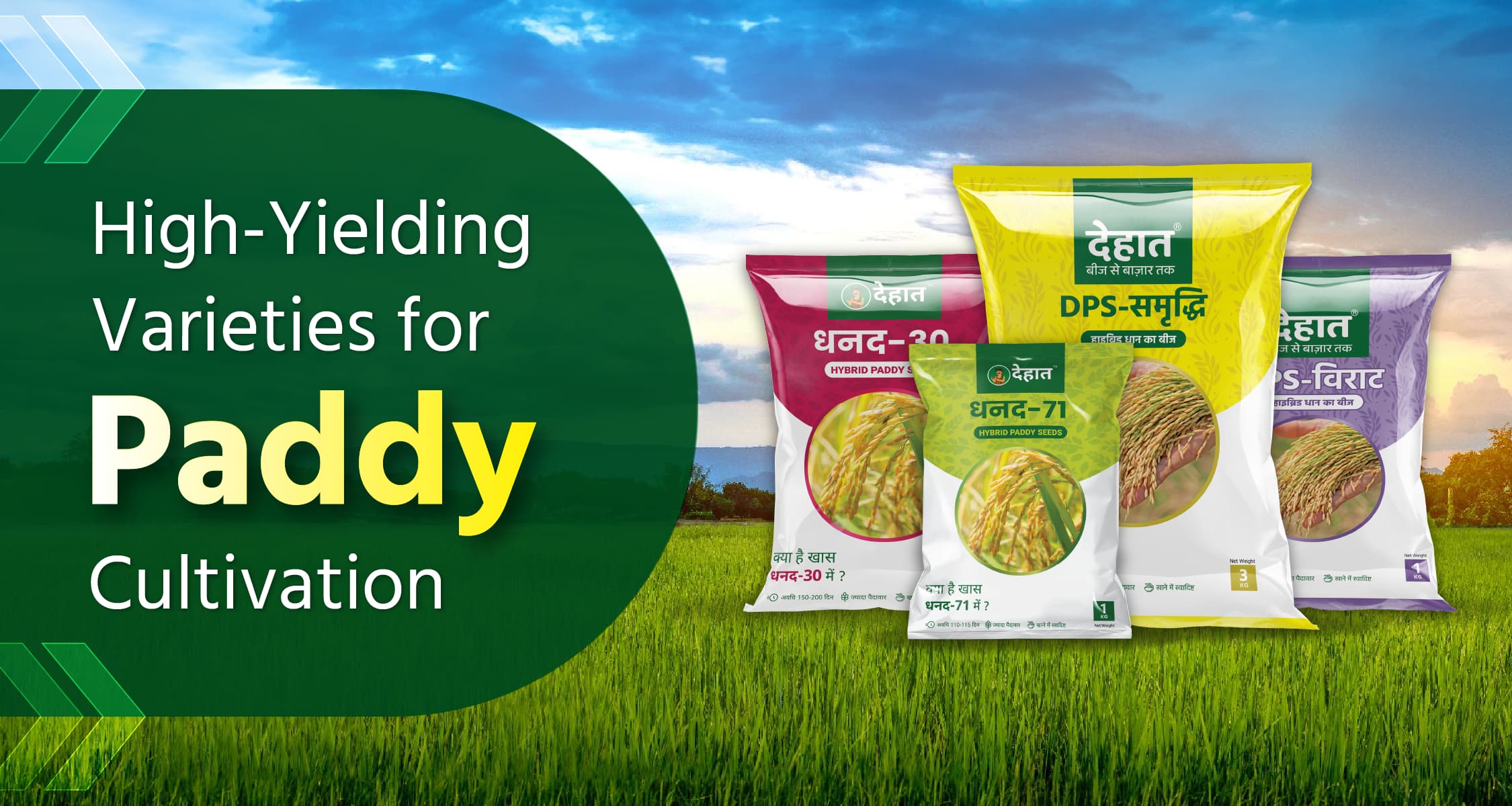High-yielding Varieties of Paddy

There can be several benefits from cultivating improved varieties of rice. Firstly, improved varieties have higher yield potential, meaning farmers can produce more rice per unit of land, thus aiding in food security and increasing income for farmers. Additionally, improved varieties often exhibit greater resistance to pests and diseases, helping to reduce cultivation costs and enhancing farming practices. Improved varieties also yield more grains, leading to higher market prices for farmers. If you want to obtain good yields of rice through paddy cultivation, you should go for improved varieties for it.
Improved Varieties of Paddy
- DeHaat DPS Dara: This is a variety of rice that matures in a medium duration of 130-135 days. It exhibits moderate tolerance to various types of pests and diseases. It has the ability to withstand stress, with plant height of approximately 110-120 cm and seed quantity per acre ranging from 10-12 kg.
- DeHaat OP Paddy BB-11: This rice variety matures in 130-135 days. Its plant height is around 103-105 cm, and the grains are of medium size. It also has tolerance to diseases. The seed rate for this variety is 20-25 kg per acre.
- DeHaat OP Paddy BPT-5204: This variety takes approximately 140-145 days to mature, making it a long-duration type. The plant height is around 90-93 cm. It shows resistance to blast disease. The grains of this variety are small, with a seed rate of 20-25 kg per acre.
- DeHaat DPS Sartaj: It exhibits moderate tolerance to blast disease in rice and its grains are long and early maturing. Its seed rate is 8 kg per acre.
- DeHaat DPS Dhanno: This is a hybrid rice seed that matures quickly, taking approximately 120-125 days. Its grains are very long, slender, and filled with grain fragrance. Additionally, its plants are strong with very long panicles and good spikelet fertility. The seed requirement per acre is 6 kg.
- DeHaat DPS-4567: This is also a hybrid rice that matures in approximately 115-120 days. It exhibits tolerance to bacterial leaf blight and provides higher yield and quality grains. It is also tolerant to false smut. If cultivated by direct seeded rice (DSR), its seed rate is 10 kg per acre and the grains are bold and glossy. Typically, conventional sowing methods require 6 kg per acre.
- DeHaat Basmati Paddy PB-1692: This variety of rice, has certain technical specifications. It takes about 115-120 days to mature and is known for its aromatic and long grains. This type of rice plant is resistant to falling over and has a semi-dwarf structure. When it reaches maturity, it doesn't shed its grains easily. Additionally, it boasts good milling quality, meaning the grains remain intact with less breakage. For planting, you would need 8-10 kg of seeds per acre.
- DeHaat OP Paddy Mahamaya: This variety takes about 125-128 days to grow and reaches a height of 100-105 cm. Its panicles are typically 20-22 cm long, and it yields long bold grains. For sowing, you'll need around 20-25 kg of seeds per acre.
- DeHaat OP Basmati Paddy PB-1121 : This is a high-quality rice variety known for its excellent features. It takes about 135-140 days to grow and reaches a height of 100-110 cm. The grains are long, slender, and have a very aromatic fragrance, making them highly desirable. This variety is known for its high yield, making it a popular choice among farmers. For cultivation, the recommended seed rate is 8-10 kg per acre.
- DeHaat DPS Paddy Virat : This variety is tailored with technical specifications for optimal cultivation. It has a growth duration of 120-125 days, featuring long and slender grains. With built-in resistance to BLB and blast, it ensures a robust yield. Standing at a height of 85-90 cm, it exhibits a medium-tall, semi-compact plant type, ideal for various agricultural settings. For sowing, a seed rate of 6 kg per acre suffices for the cultivation process.
- DeHaat DPS Samridhi: This variety has some key technical specifications. It takes around 120-125 days to grow. The plant produces long panicles with a good spike length and is moderately tolerant to insects and diseases. It can handle stress fairly well and its grains have good cooking quality. The plant usually grows to a height of 110-120 cm. For cultivation, the recommended seed rate is 6 kg per acre.
- DeHaat DPS Double Gold : This variety is a high-quality rice variety designed to excel in various conditions. With its resistance to bacterial leaf blight (BLB), DPS Double Gold ensures healthy crop cultivation. It consistently delivers yields 25-30% higher than other popular inbred varieties, with a duration of 135-140 days. Its wider adaptability makes it suitable for diverse environments. Moreover, it offers more than 70% milling recovery, ensuring quality grain. DPS Double Gold is also ideal for Direct Seeded Rice (DSR) systems, requiring a seed rate of 10 kg/acre. For optimal performance, the recommended seed rate is 6 kg/acre.
- DeHaat GAPL Paddy IR-64 : This has certain technical specifications: it matures in 115-120 days, with a plant height ranging from 95 to 98 cm, and it produces grains that are medium-long and medium-bold. For sowing, the recommended seed rate is 20-25 kilograms per acre.
What variety of improved paddy seeds do you cultivate, and what is its yield like? Let us know your experience and other inputs through comments. Follow the 'DeHaat' channel for more information on DeHaat's products. Also, don't forget to like and share this post.
Frequently Asked Questions (FAQs)
Q: What do we mean by improved seed varieties?
A: Improved seed varieties are seeds that are cultivated through a specialized process of seed production tailored to a specific area. These seeds are equipped with a set of specific agricultural practices, surpassing local varieties in various aspects, and enable farmers to achieve a superior harvest due to their genetic potential for increased production.
Q: What fertilizer is most effective for increasing rice production?
A: The optimal fertilizer for rice cultivation is Potassium (K). Potassium, in particular, plays a crucial role in achieving high rice yields. It enhances the rice's resistance to diseases, stimulates root growth and thickness, and encourages leaf development, all contributing to improved productivity.
Q: In which regions of India is rice farming most prominent?
A: As of the 2020-21 period, the leading three states in rice production in India are as follows:
- West Bengal
- Uttar Pradesh
- Punjab
Together, these three states contribute around 36% of India's overall rice output. Specifically, West Bengal accounts for 13.62% of the nation's total rice production, Uttar Pradesh contributes 12.81%, and Punjab contributes 9.96%.
Please login to continue

Get free advice from a crop doctor
